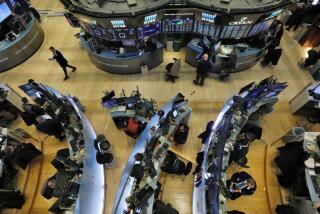CURRENCY : Dollar Continues Upward Climb Despite Intervention
NEW YORK — The dollar climbed Monday, undaunted by rounds of selling by major central banks hoping to stem the currency’s sharp rise.
It was the second major move for the currency in as many days. On Friday, the dollar shrugged off a larger-than-expected increase in the February unemployment rate and a surprise cut in a key U.S. interest rate.
On Monday, optimism about the health of the postwar U.S. economy sent the dollar soaring, traders said.
In New York, the unified selloffs helped knock the dollar off its highs for the day. The dollar, which traders said peaked at 1.5870 German marks earlier in the U.S. session, ended at 1.5815 marks.
The Japanese yen settled at 138.20 yen, up from Friday’s 136.82.
In Europe, the dollar had touched 1.5865 marks and 138.65 yen.
“It seems to be the overwhelming consensus that the worst is past and the outlook for the future is much brighter,” said Bill English, senior trader at Banca Nazionale Dell’Agricoltura. “There is overwhelming support for this theory.
“Euphoria goes on,” he said. “It’s difficult to deal in a market which can’t be concerned about reasons.”
Currency analyst David Gilmore at MCM Currencywatch added words of caution, remarking that there was “no conclusive evidence that the economy is rebounding.”
“The market is ahead of itself,” he said. “It is trading on expectations.”
The Federal Reserve, the German Bundesbank and the Bank of England, among others, teamed up to halt the rise, but the dollar still managed to poke its head up.
The central banks launched a two-pronged attack, selling dollars as the currency appeared poised to head toward 1.60 German marks and 140 Japanese yen, dealers said.
The dollar had broken through the key resistance levels of 1.5800 marks and 138.00 yen in Europe, prompting the first round of central bank intervention.
Initially, the central banks of Germany, Austria, Belgium, Switzerland, Denmark, Sweden, Norway, Finland, Spain, Portugal and England intervened in Europe.
Later the Federal Reserve jumped in to try to trip up the surging dollar, and it was joined by Canada.
“They really mean business,” said one trader in Frankfurt, Germany. The volume of dollars sold for German marks was heavy, he said.
Dealers said the selling pulled the dollar from its highs.
On Friday, the dollar rose despite the Fed’s lowering of the federal funds rate--which banks charge each other for overnight loans--to 6% from 6.25%.
Lower rates tend to stimulate economic activity but they also hurt the dollar by making returns more attractive on foreign currencies.
The Fed acted after the government reported that unemployment rose in February to a four-year high of 6.5%.
“The underlying tone for the dollar certainly seems to be up,” said Vice President Frank Pusateri at Bank of Boston. Central banks wanted to signal the market to “put the brakes on,” he added.
The British pound also slipped in New York, where sterling fetched $1.8515, down from Friday’s $1.8645.
Other late dollar rates in New York, compared to late Friday’s rates, included: 1.3705 Swiss francs, up from 1.3692; 5.3845 French francs, up from 5.3515; 1,180.00 Italian lire, up from 1,174.00, and 1.1558 Canadian dollars, down from 1.1614.
More to Read
Sign up for Essential California
The most important California stories and recommendations in your inbox every morning.
You may occasionally receive promotional content from the Los Angeles Times.









